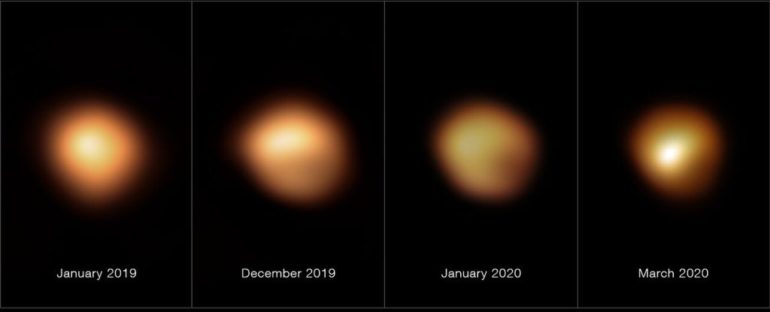It’s official: Betelgeuse sneezed and caught a cold.
The cause of the star’s mysterious drop in brightness was caused by a giant cloud of dust, ejected from the red supergiant – but it could only do so because the star’s changing temperature allowed it.
Betelgeuse’s Great Dimming, as the event has come to be known, baffled astronomers. The star, usually one of the brightest in the sky, started dimming in September 2019. By February 2020, it had dimmed by 35 percent, behavior that had never been observed before.
Images of the star’s surface taken during the event using the European Southern Observatory’s Very Large Telescope clearly show the changes in Betelgeuse’s brightness. With these new data, astronomers say, a sneeze of gas condensing into dust due to surface cooling really is the best explanation that fits.
This is tremendously exciting, because it could help us understand a process that has long been a mystery: how massive stars eject their mass before going supernova and seeding the Universe with heavy elements.
“We have directly witnessed the formation of so-called stardust,” said astrophysicist Miguel Montargès of the Observatoire de Paris in France and KU Leuven in Belgium.
When astronomers were observing the Great Dimming, there were two main contenders as to its cause: stellar surface cooling, or a dust cloud ejected by the star as it undergoes mass loss.
Red giants like Betelgeuse are unstable. It’s the twilight life stage for really chonky stars, between around 8 and 35 times the mass of the Sun. These stars burn very hot, and have relatively short lifespans; Betelgeuse is thought to be just 8 to 8.5 million years old, and its main sequence days were done around 1 million years ago (the Sun is around 4.6 billion years old, and only halfway through its life).
Betelgeuse puffed out into a red supergiant about 40,000 years ago. By now, the star has run out of hydrogen in its core, and is fusing helium into carbon and oxygen. The star’s core has also contracted, which brings more hydrogen into the region immediately around the core, forming a hydrogen shell; this hydrogen shell fuses into helium, which is then dumped into the core to fuel the helium fusion.
Eventually, the star will reach a point at which its core has insufficient heat and pressure to continue fusing elements, and it will go supernova, turning into either a neutron star or a black hole. That won’t happen for some time, though.
But, before stars like these go supernova, they eject mass into the surrounding space, spreading around all those heavy elements they fused in their cores. This process is poorly understood.
“One of the main mysteries about red supergiant stars is that we do not know how their mass loss is triggered,” Montargès told ScienceAlert.
“We know it is happening but we do not understand the mechanism that allows the material to leave the photosphere of the star. Here we may have witnessed a more intense mass loss episode of Betelgeuse, or perhaps the regular mechanism. Indeed it could be losing its mass all the time like this, but only in other directions, not causing any dimming.”
According to a previous analysis undertaken using images from the Hubble Space Telescope, a cloud of dust seemed likely. With the images from the VLT, Montargès and his team were able to expand on that.
Because Betelgeuse is so large, and so close to Earth (the most recent measurement puts it at 548 light-years away, putting the star’s size at 764 times that of the Sun), it appears as a disc through a telescope. That means the VLT was able to clearly show the dimming was localized to the star’s southern hemisphere.
Using modelling, Montargès and his team then explored the possibilities. Their results suggested that the drop in brightness was the result of both cooling and dust. According to their findings, a bubble of gas was ejected by Betelgeuse some time prior to the dimming; this was observed by Hubble.
“With Hubble, we could see the material as it left the star’s surface and moved out through the atmosphere, before the dust formed that caused the star to appear to dim,” said astrophysicist Andrea Dupree of the Harvard-Smithsonian Center for Astrophysics, who worked on both papers.
Later, when a patch of the star’s photosphere cooled in just the right place, the drop in temperature was sufficient for some of the vaporous elements in the bubble, such as silicon, to condense and harden into grains of dust. It was this dust cloud that obscured the star’s light.
The team hopes that this information will help them find signs of similar mass loss in other red giant stars. In the meantime – dimming or not – the shine hasn’t gone off Betelgeuse. The star has surprised everyone, and astronomers will continue to watch it for signs of other strange behavior.
“I have been wanting to witness a mass loss event of a red supergiant for a long time. Here we see it on the line of sight (causing a dimming) and it happens on the most famous red supergiant of all: Betelgeuse. I still can’t believe it,” Montargès said.
“But the most exciting part was to stand outside in winter 2019-2020 and to see the star so dim compared to Rigel. How often can we see a star change its appearance so much? That was a privilege to witness.”
The research has been published in Nature.



